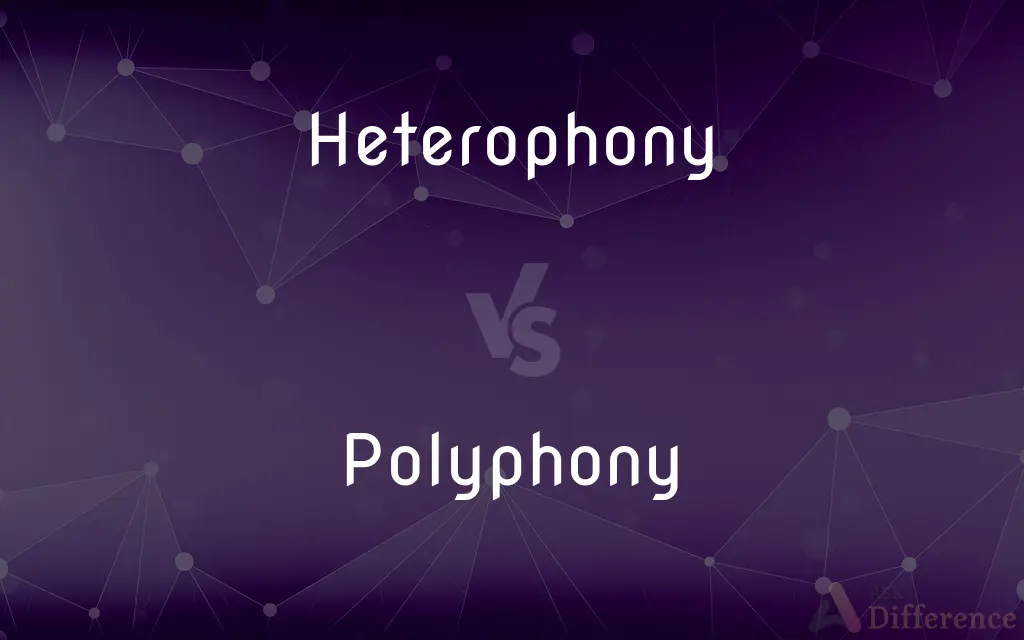Heterophony vs. Polyphony — What's the Difference?
By Maham Liaqat & Fiza Rafique — Updated on April 19, 2024
Heterophony involves multiple performers playing simultaneous variations of a single melodic line, while polyphony features multiple independent melodic lines interwoven together.

Difference Between Heterophony and Polyphony
Table of Contents
ADVERTISEMENT
Key Differences
Heterophony is characterized by a texture where several musicians play variations of the same melody at the same time, often embellishing the melody differently. On the other hand, polyphony involves the interweaving of several independent melodic lines, each maintaining its distinct melodic contour and rhythm, which are harmonically interdependent.
In heterophony, the variations around the melody are typically spontaneous and improvisational, reflecting individual musicians' interpretations. Whereas in polyphony, the melodic lines are often composed with precise interaction in mind, aiming for a balanced and harmonically sound ensemble.
Heterophonic textures are common in traditional music of Asian and Middle Eastern cultures, where the concept of a solo melody with slight individual variations is a foundational musical practice. In contrast, polyphony is a hallmark of Western classical music, particularly evident from the Renaissance through the Baroque period, emphasizing complex arrangements and contrapuntal techniques.
The aesthetic of heterophony leans towards a more fluid and organic sound, as performers might vary the melody by changing rhythm, timbre, or scale ornaments. On the other hand, polyphony focuses on structural harmony and the mathematical beauty of interlocking parts, creating a rich tapestry of sound where each line is integral to the overall texture.
Heterophony typically requires less formal training as it relies more on the musician's ability to interpret the melody in real-time. Polyphony, however, often demands extensive musical training and understanding of harmonic theory to navigate the multiple, interacting musical lines.
ADVERTISEMENT
Comparison Chart
Definition
Variation of a single melody by multiple parts
Multiple independent melodies played together
Musical Texture
Monophonic with variations
Complex and interwoven
Cultural Origin
Common in Asian and Middle Eastern music
Originated in Western classical music
Improvisation
High, with spontaneous variations
Low, generally composed and structured
Aesthetic Outcome
Organic and fluid
Structured and harmonically rich
Compare with Definitions
Heterophony
Simultaneous variation of a single melody.
In the performance, each musician played a slightly different version of the melody, creating a rich heterophony.
Polyphony
Structurally complex and harmonically interdependent.
The quartet's performance featured tightly interwoven polyphonic lines, creating a dense musical texture.
Heterophony
Common in folk and traditional music.
Traditional Thai music often employs heterophony, giving it a unique, layered sound.
Polyphony
Interweaving of several independent melodic lines.
Bach's fugues are celebrated for their complex polyphonic structures.
Heterophony
Emphasizes individual expression within a shared framework.
The ensemble's heterophonic texture highlighted each player's stylistic nuances.
Polyphony
Characteristic of Western classical music.
Renaissance choirs showcased elaborate polyphony in their vocal arrangements.
Heterophony
Organic and improvisational.
The musicians spontaneously varied the melody, weaving a complex heterophonic texture.
Polyphony
Requires precise compositional technique.
Composing polyphonic music requires a deep understanding of harmonic and contrapuntal rules.
Heterophony
Fluid and adaptable musical practice.
Heterophony allows musicians to adapt the melody to their instruments and personal styles.
Polyphony
Aesthetic focus on balance and harmony.
The composer's use of polyphony enriched the piece, offering a harmonious blend of independent voices.
Heterophony
In music, heterophony is a type of texture characterized by the simultaneous variation of a single melodic line. Such a texture can be regarded as a kind of complex monophony in which there is only one basic melody, but realized at the same time in multiple voices, each of which plays the melody differently, either in a different rhythm or tempo, or with various embellishments and elaborations.
Polyphony
Polyphony is a type of musical texture consisting of two or more simultaneous lines of independent melody, as opposed to a musical texture with just one voice, monophony, or a texture with one dominant melodic voice accompanied by chords, homophony. Within the context of the Western musical tradition, the term polyphony is usually used to refer to music of the late Middle Ages and Renaissance.
Heterophony
The simultaneous playing or singing of two or more versions of a melody.
Polyphony
Music with two or more independent melodic parts sounded together.
Heterophony
(music) The simultaneous performance by a number of singers or musicians of two or more versions of the same melody.
Polyphony
(music) Musical texture consisting of several independent melodic voices, as opposed to music with just one voice (monophony) or music with one dominant melodic voice accompanied by chords (homophony).
Heterophony
An abnormal state of the voice.
Polyphony
The quality of a text of being capable of being read in more than one way.
The polyphony of a biblical passage
Polyphony
Multiplicity of sounds, as in the reverberations of an echo.
Polyphony
Plurality of sounds and articulations expressed by the same vocal sign.
Polyphony
Composition in mutually related, equally important parts which share the melody among them; contrapuntal composition; - opposed to homophony, in which the melody is given to one part only, the others filling out the harmony. See Counterpoint.
Polyphony
Music arranged in parts for several voices or instruments
Common Curiosities
Can heterophony and polyphony be combined in a single piece?
Yes, some compositions blend heterophonic and polyphonic textures, using the techniques to enrich the musical landscape.
Is heterophony common in modern music?
While less common in Western popular music, heterophony is still prevalent in many forms of traditional and world music.
What skills are essential for performing polyphonic music?
Musicians need to have strong sight-reading abilities, a good understanding of harmony, and the ability to maintain an independent musical line.
What is heterophony in music?
Heterophony is a texture where multiple performers play variations of the same melody simultaneously, each adding personal embellishments.
How does polyphony differ from homophony?
Polyphony involves multiple independent lines, while homophony consists of a dominant melody supported by chords or a harmonious accompaniment.
How does one compose polyphonic music?
Composing polyphony involves understanding counterpoint, where each voice must independently make melodic sense yet harmonize with others.
What instruments are typically involved in heterophonic textures?
Any instruments can participate, but it's particularly common in ensembles of traditional string or wind instruments.
What are the challenges of playing in a heterophonic texture?
Challenges include maintaining the melody while creatively embellishing it without overshadowing other variations.
Why is polyphony important in music history?
Polyphony was crucial in the development of Western music, influencing compositional techniques and musical complexity.
How does cultural context influence the use of heterophony?
Cultural traditions dictate the prevalence and style of heterophony, often reflecting a community's musical heritage and aesthetic preferences.
Can a solo performer create heterophony?
Typically, heterophony involves multiple performers, though a soloist can imply heterophony through varying a melody in successive repetitions.
How do musicians coordinate in a polyphonic ensemble?
Coordination requires listening skills, knowledge of the piece, and often a conductor or leader to maintain balance among the lines.
What effect does polyphony have on the listener?
Polyphony can create a rich, immersive listening experience due to the complexity and interplay of its multiple lines.
What educational background is helpful for understanding polyphony?
A background in music theory, particularly in Baroque and Renaissance music, helps in understanding and performing polyphony.
What is a famous piece of polyphonic music?
Palestrina's "Missa Papae Marcelli" is renowned for its polyphonic clarity and beauty.
Share Your Discovery

Previous Comparison
Sifu vs. Shifu
Next Comparison
Benzene vs. BenzineAuthor Spotlight
Written by
Maham LiaqatCo-written by
Fiza RafiqueFiza Rafique is a skilled content writer at AskDifference.com, where she meticulously refines and enhances written pieces. Drawing from her vast editorial expertise, Fiza ensures clarity, accuracy, and precision in every article. Passionate about language, she continually seeks to elevate the quality of content for readers worldwide.














































